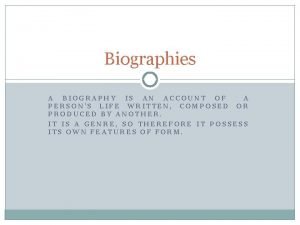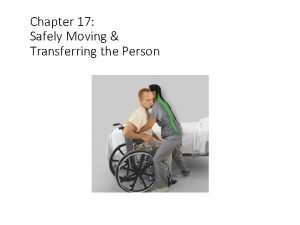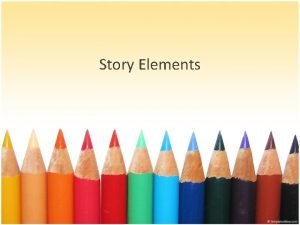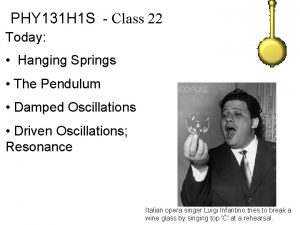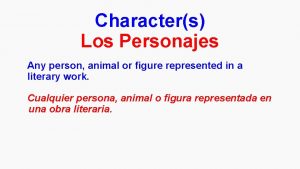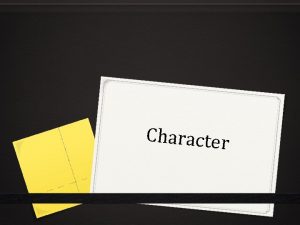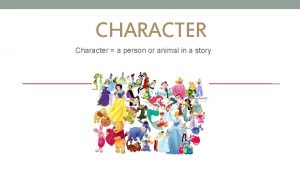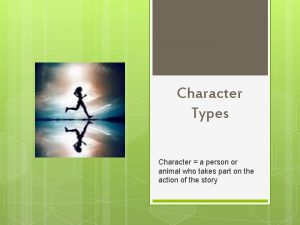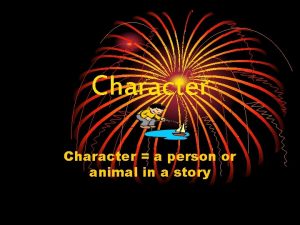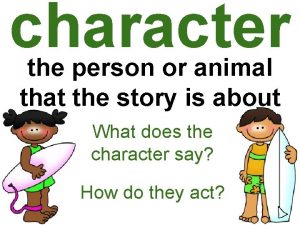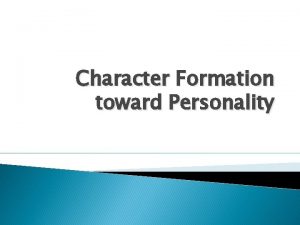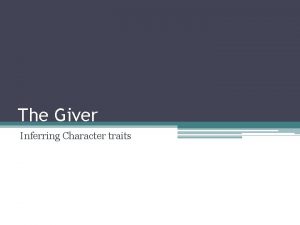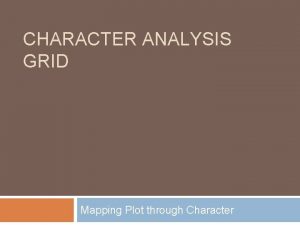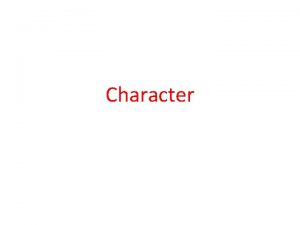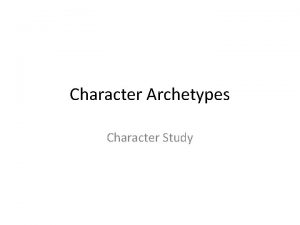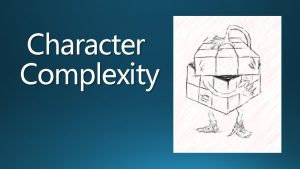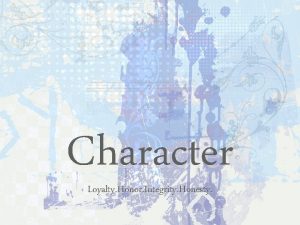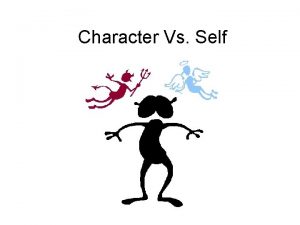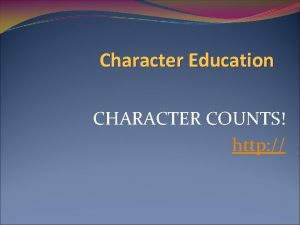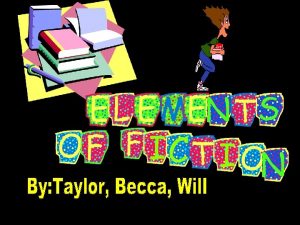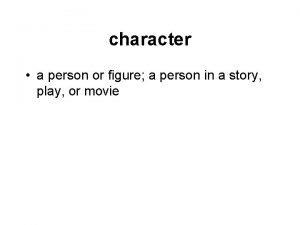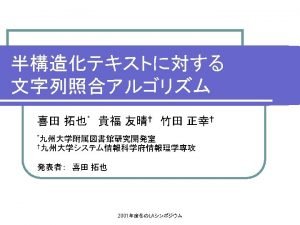Character a person or animal in a story






















- Slides: 22

Character = a person or animal in a story

Characterization The methods used by the author to create or reveal the characters in a story. (can be direct or indirect)

Direct Characterization The method of character development in which the author simply tells you what the character is like. For example, “Miss Alice was the nicest person you would ever want to meet, ” is direct characterization.

Indirect Characterization The method of characterization that is most similar to the way we learn about people in real life. Using indirect characterization, the author presents the character’s personality through what he/she says, his/her actions, or how other characters relate to him/her. You must then draw your own conclusions about the character.

Example of Direct or Indirect Characterization? Read the following example of characterization. Decide whether it is an example of direct or indirect characterization. (A) James was one of those people who was constantly angry. He looked for trouble wherever he went, and he usually found it.

Example of Direct or Indirect Characterization? (B) Stanley’s eyes blazed as he surveyed the room. The corners of his mouth pointed in a decidedly southerly direction. Carol moved aside as he stalked past her. “Look out for Stan, ” she whispered to Bart. “He’s in another one of his moods. I’d stay far away if I were you!”

Description A is an example of direct characterization. The author comes right out and tells you that James was always angry, and that he was looking for a fight almost constantly.

Description B is an example of indirect characterization. We can tell from his angry eyes, frowning mouth and the way he walked that he is angry. We can also see that others are somewhat frightened by him by observing their reactions. Carol moves aside and warns Bart to avoid Stanley.

Which method is more effective in developing the character? Why do you think so?

Methods of Characterization creating believable characters… INDIRECT -physical appearance -the narrator’s direct comments about a character -speech, thoughts, feelings, or actions of the character -speech, thought, feelings, actions of other characters

Types of Characters… • Major • Minor

Major Character The major (main) character in a story is like the star of a movie and is central to the action that takes place.

Minor character… A minor character is one who takes part in the action but is not the focus of attention.

Types of Characters • The protagonist (or main character) is the central figure in the work. • The antagonist is the character or force pitted against the protagonist.

More types of characters… • A static character does not change through the course of the action. • A dynamic character is one who does change.

Round Character A round character is a complex, fully developed character.

Flat Character A flat character is a onedimensional character, typically not central to the story

The protagonist is usually… • The central character • A character the reader can identify with • Has a rounded personality (we hear what they say, what others say about them, we know what they think and how they feel) • A character with a dynamic personality

Secondary characters are usually… • Static • Flat

Character Motivation A motive is a reason that explains or partially explains a character’s thoughts, feelings, actions, or speech. If the motives of a main character are not clear, then the character will not be believable. Characters are often motivated by needs, such as food and shelter. They are also motivated by feelings, such as fear, love, and pride. Motives may be obvious or hidden.

Character’s Qualities or Traits The personal traits that make up the character’s personality.

Dialogue is a conversation between two or more people. Dialogue is usually set off by quotation marks to indicate a speaker’s exact words.
 Höflichkeitsform plural
Höflichkeitsform plural 2nd person point of view
2nd person point of view Person person = new person()
Person person = new person() Example of personal pronoun
Example of personal pronoun The main person,animal or object in a story
The main person,animal or object in a story What is a person or animal in a story
What is a person or animal in a story The main person animal or object in a story
The main person animal or object in a story Person, animal or thing that does the action.
Person, animal or thing that does the action. We is second or third person
We is second or third person First person vs third person writing
First person vs third person writing Person-job fit and person-organization fit
Person-job fit and person-organization fit What is montag's internal conflict
What is montag's internal conflict![Private string[] Private string[]](data:image/svg+xml,%3Csvg%20xmlns=%22http://www.w3.org/2000/svg%22%20viewBox=%220%200%20200%20200%22%3E%3C/svg%3E) Private string[]
Private string[] Chapter 18 safely moving the person
Chapter 18 safely moving the person Biography features
Biography features One persons trash is another persons treasure
One persons trash is another persons treasure When a person is logrolled, the person is
When a person is logrolled, the person is The lion and the mouse plot diagram
The lion and the mouse plot diagram Person a and person b
Person a and person b A person swings on a swing when the person sits still
A person swings on a swing when the person sits still Hi how are you what are you doing
Hi how are you what are you doing Any person animal or figure represented in a literary work
Any person animal or figure represented in a literary work Plant vs animal cells
Plant vs animal cells
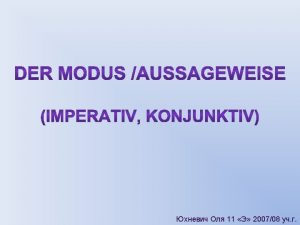
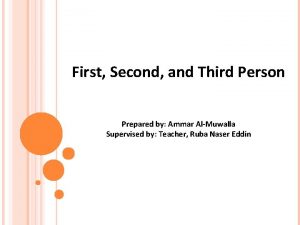

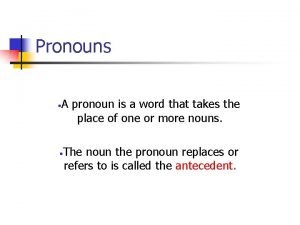
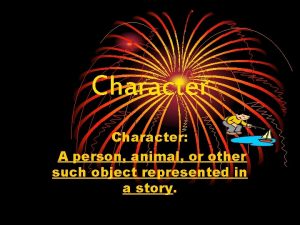
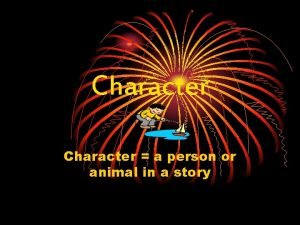



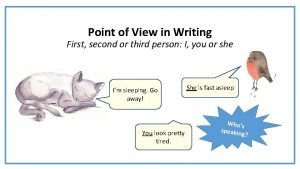

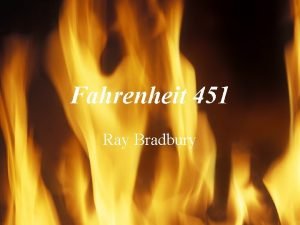
![Private string[] Private string[]](https://slidetodoc.com/wp-content/uploads/2020/12/3088144_f6d6e306d8f29e1538b2c0f548f94d87-300x225.jpg)

